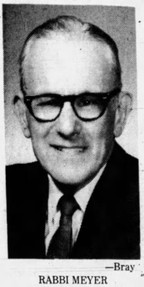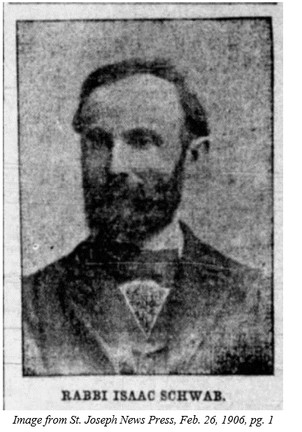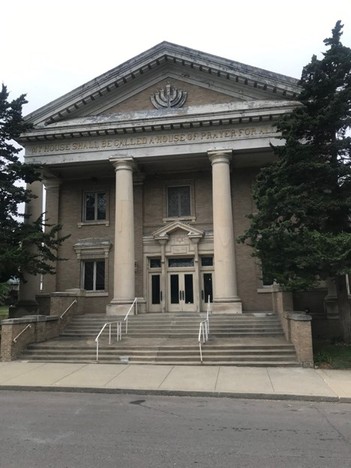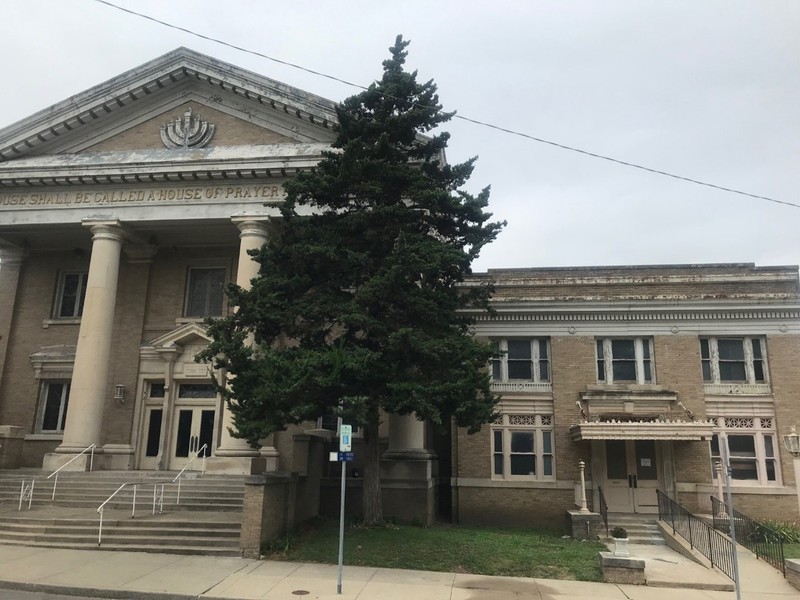Temple Adath Joseph
Introduction
Text-to-speech Audio
The earliest Jewish settlers to St. Joseph came primarily from the German areas of Europe. Arriving in about 1849, nearly immediately they established the Adath Joseph congregation. Initially the small congregation comprised of between 15 to 20 men and their families held its services in a hall on Felix Street. This earliest group did not have a Rabbi, so M. Lehman served as lay leader. In 1857 the group purchased the former Cumberland Presbyterian Church at 6th and Edmond Streets and renovated it for their use. Unfortunately, that structure burned not long after. One of the congregation, Mr. Harburger, rescued the scrolls. The congregation then built on the southeast corner of 6th and Jules, dedicating the new synagogue in the fall of 1868. The size of the congregation reflected the growth of the community: forty-two men and their families worshipped there. It was at this time that a division in the Jewish community of St. Joseph began to emerge; Adath Joseph was becoming increasingly reformed in character (more liberal) while the congregation at B’Nai Yakov (comprised largely of immigrants from imperial Russia) remained resolutely orthodox (more conservative).
The Adath Joseph congregation continued to thrive economically prompting them to engage the services of renowned St. Joseph architect Rudolph Meier and commission him to design an imposing synagogue at 102 N. 17th St., Temple Adath Joseph. Meier was given a substantial budget ($32,000) and did not fail in his commission to create an imposing structure.
The Temple was dedicated in September 1910 with a week of elaborate ceremony. Prominent Rabbis from across the country participated. The Torah scrolls were installed and the perpetual light kindled.
In 1923, the annex was built to serve as a social center. The substantial structure contained a banquet room, parlors, a kitchen, and a gymnasium. The architect for the annex was Eugene Meier, the younger brother of Rudolph Meier who designed the Temple.
Following World War Two, the Jewish population of St. Joseph declined sharply as did the congregation of Temple Adath Joseph. By the mid-2010s it was clear that the there were not enough active members to sustain both Adath Joseph and the Conservative synagogue, B’Nai Sholem and the difficult decision was made to merge. Since the merger, services have been held at Adath Joseph while B’Nai Sholem was closed and eventually sold.
The members of the Adath Joseph congregation were largely of German ethnicity and considered relatively liberal. For much of its history, its congregants were buried at the Adath Joseph Cemetery (site on tour).
Rabbis for the Adath Joseph Congregation:
· M. Kaufman, earliest days until 1875
· S. Gerstman, 1875-1879
· Isaac Schwab, (born in 1841) 1879-1906. Rabbi Schwab, born in Bavaria, was known as a great scholar. In 1906, the congregation did not re-elect him to his post, prompting him to sell most of his property in St. Joseph and move to Chicago to take up a career in religious journalism. When he retired the congregation awarded him a pension of $1,000 (per year). He died soon after in Chicago.
· Louis Bernstein, (1882-1921). 1906-1921. Born in New Albany, Indiana to a Russian father and a German Mother. During the tenure of Rabbi Bernstein, the congregation grew substantially and the Temple was constructed. Bernstein played a prominent part in the civic life of St. Joseph, serving on the board of the Associated Charities and on the Public Library Board. He left in 1921 to take over a congregation in Baltimore, MD.
· Gary August, 1921-1926. Rabbi August came to St. Joseph from a post in Joplin, MO. It was during his time that the annex was constructed. In 1926, he moved to Gary, ID.
· Myron M. Myer, (1896-1974) 1927- 1968. Rabbi Myer, born in Dallas and educated at the University of Cincinnati and the Hebrew Union College in Cincinnati, came to St. Joseph from Alexandria, LA. .Rabbi Meyer was a prominent voice in St. Joseph’s religious, educational, and cultural life. He had been a director of the St. Joseph symphony society. He was professor emeritus at Missouri Western State College at the time of his death, teaching philosophy and comparative religion.
· John Rosenblatt, 1968-
· Stephen A. Arnold, 1974
· Wolfgang Hamburger, 1983
· Jeffrey Glickman, 1989-1995
· Matt Friedman, 1997 - 1999
Rabbis after this point were part-time and served one-year terms.
· Lynn Koshner, 1999-2000
· Eileen Kollins, 2003
· Debbie Stiel, 2005
· Amy Bigman, 2006
· Audrey Korotkin
Among the prominent congregants were David Siegal (link to the S. 10th); the Westheimers
Images
Rabbi Meyer





Backstory and Context
Text-to-speech Audio
The Sept. 16, 1910 News-Press described the Temple: “The new church, of brick and stone, is of Greek design. Rudolph Meier was the architect. The interior woodwork is mahogany and the assembly room is one of the handsomest in the city. Illumination is by five chandeliers wrought in the familiar interlaced triangle design, by side lamps in the style of Jewish Sabbath lights, and by ten large stained glass windows, with smaller windows overhead. A novel plan has been followed in these. Each of the small windows bears a symbol, while the larger window below bears an appropriate inscription. Thus, the representation of a Sabbath light, emblematic of the home, and, accordingly, love, has below it the inscription, ‘Thou shalt love they neighbor as thyself.’
“The church contains a balcony, organ loft, rabbi’s study, clubrooms and classrooms for the Sunday school. The building and property represent an investment of $50,000.
“The organ is declared to be one of the best in St. Joseph. It was built by M.P. Moeller of Hagerstown, Md.”
Above the entrance to the Temple is inscribed, “My house shall be called a house of prayer for all people.”
Annex: Opened in 1923. Described by the News-Press on Feb. 17, 1923: “Construction is of buff brick, with cut stone trimmings, the classic style of architecture and material conforming to that of the church proper, except that the annex style conveys more the impression of a social center. At either side of the entrance is a bronze lamp standard, and overhead a copper marquis.
“The entrance vestibule is of tile and marble. Radiators are concealed. The reception room has a coat room and stairway leading to the women’s reception and rest rooms. The general reception room is connected with the banquet hall by French doors. The same kind of doors form a connection between the women’s reception room and the banquet hall balcony.
“The beauty center of the annex is the banquet hall. It is finished in ivory enamel, with light fixtures carrying out the tone of old gold and ivory. The chairs are finished in gold. The overdrapes and stage curtain are of silk rose velour, with gold fringe. The windows are of the casement type, with divided lights to correspond to the French doors. The windows on the south wall, which forms a dividing line between the annex and the church, are constructed of mirrors to correspond to the outside windows on the north side.
“The banquet hall is commodious, with dimensions 60x40 feet and 18-foot ceiling. Several hundred may be accommodated at dinners. The lovely room also is designed to be used for teas, receptions, musicales, plays, and social gatherings of various sorts. At the west end is a stage with the velour curtains, stage scenery, and footlights. Beneath the stage is storage space for chairs and tables.”
Cite This Entry
Schutte, Kim. "Temple Adath Joseph." Clio: Your Guide to History. November 16, 2022. Accessed April 1, 2025. https://theclio.com/tour/2349/4/reverse
Sources
“New Temple to be Dedicated Next Week,” St. Joseph News-Press, Sept. 16, 1910, pg. 15.
“Dedication Tonight of Jewish Temple,” St. Joseph News-Press, Sept. 23, 1910, pg. 24.
“Adath Joseph Temple Has a Social Center,” St. Joseph News-Press, Feb. 17, 1923, pg. 3
“Adath Joseph Congregation Dates Back to 1860, Synagogue was Built in 1910,” St. Joseph Gazette, Dec. 23, 1928, pg. 6B,
“100th Anniversary Celebration for Temple Adath Joseph,” St. Joseph News-Press, Nov. 11, 1956, pg. 7.
“Death Takes Rabbi Myron M. Meyer,” St. Joseph Gazette, Nov. 27, 1974, pg. 1.
Phyllis Wright, “United yet Distinct, Small but Strong,” St. Joseph News-Press, pg. 8B.
“Mulling a Merger,” St. Joseph News-Press, Nov. 8, 1997, pg. D1.
“Rabbi Gerstman Resigns,” St. Joseph Gazette, Jan. 21, 1879.

